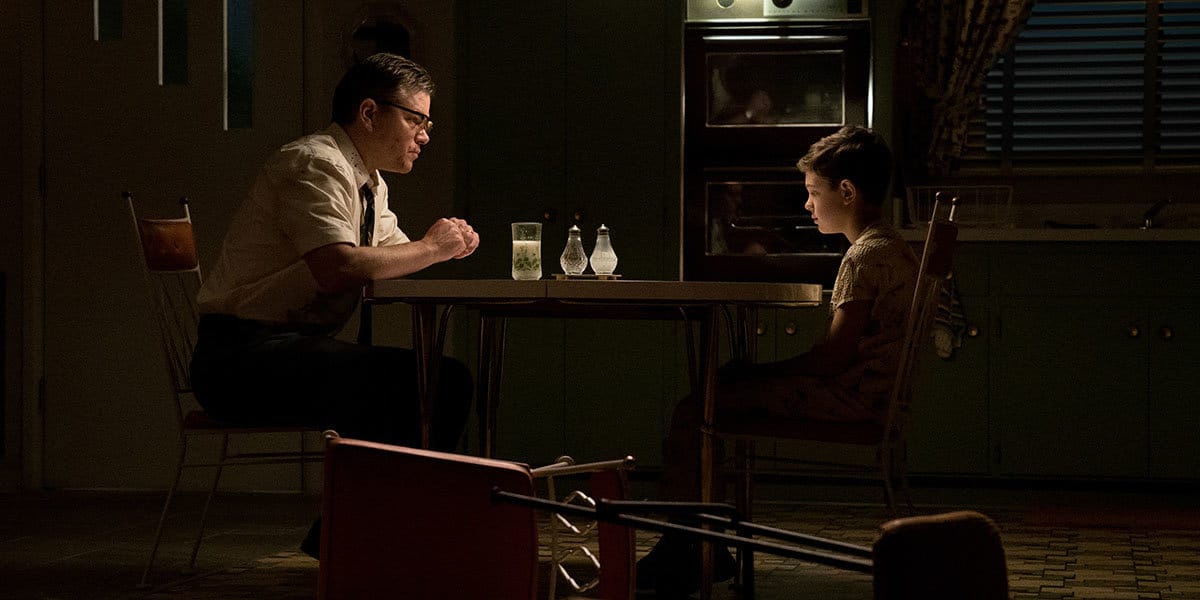
To Kill a Mockingbird (1962)
Suburbicon is best when it’s consistent with its most interesting point of view, depicting the events of the neighborhood integration and the actually horrible situation of the Lodge family home through the eyes of young Nicky Lodge (Noah Jupe). We see everything through a perspective of innocence that doesn’t understand why interracial friendships are frowned upon or what’s going on between his father and aunt, romantically or criminally. The movie would be much better if Clooney stuck with the focalization of this being solely Nicky’s story.
When the boy’s POV does dictate the narrative and the limited-perspective cinematography, Suburbicon feels reminiscent of this iconic adaptation of Harper Lee’s classic, Pulitzer Prize-winning novel. The book and the movie stick primarily with the focalization of young Scout Finch, as she observes her small town and the events surrounding a rape trial involving an African-American man and a white girl. As in the case of Suburbicon, the white people are shown to be the ones to be afraid of in the community.
Crimewave (1985)
Following their own feature debut as directors with 1984’s Blood Simple, the Coen brothers collaborated with their friend Sam Raimi (just off his own debut, The Evil Dead) on the script for this goofy comedy that blends his brand of slapstick horror and their brand of slapstick crime film and screwball farce. Although the Coens have been working on a number of scripts for other people lately, Crimewave was for a long time the only movie they had co-written but not directed. And unlike Unbroken and Bridge of Spies, yet similar to Suburbicon, this one does feel more like something that they could have or should have made themselves.
Somewhat appreciated now as an earlier hint of what was to come from both Raimi and the Coen brothers, at the time it was hard to swallow for audiences, especially those looking for more serious, straight genre fare from the parties involved. The movie, which is downright “Looney Tunes” in its comedic style, is about an innocent man (Reed Birney) awaiting execution via electric chair who flashes back to the crazy, convoluted murderous plot that got him there. Like Suburbicon, it doesn’t always work and feels like a mashup of authorship but if you’re a diehard Coens fan, there are enough recognizably Coenesque elements to enjoy at least some of the movie.
Parents (1989)
To young children, walking in on their parents having sex can be a terrifying experience, especially if they don’t know or realize it’s love making and not Daddy hurting Mommy. That’s something depicted in both Suburbicon, albeit with Nicky’s father and aunt doing it, which would be especially confusing, and this dark suburban comedy also set in the 1950s. Here the boy also discovers his guardians are murderers, but they kill because they’re cannibals not greedy insurance money hounds, and as a result his father tries to kill him, too.
Actor Bob Balaban made his feature directorial debut with this movie, the soundtrack of which boasts music composed by Angelo Badalamenti. That gives it a nice connection to the work of David Lynch, especially the secretly seedy suburbia of Blue Velvet, and to the work of Jean-Pierre Jeunet, whose City of Lost Children is scored by Badalmenti but whose Delicatessen involves turning humans into meat for consumption. Like Suburbicon, its biggest offense is in its inconsistency of tone, but it has some good moments still.
Celia (1989)
This obscure Australian feature by Ann Turner also depicts events through the eyes of a child, the eponymous pigtailed 9-year-old (Rebecca Smart). The strange tale is, like Suburbicon, set in 1957 suburbia and similarly combines a frightening home situation with a bigger political and cultural backdrop. As the height of the Red Scare in Melbourne metaphorically is related to concerns about the rabbit population in Australia, Celia has personal ties to both: her grandmother, whom she finds dead at the start of the movie, was a member of the Communist Party; and later she’s gifted a beloved pet bunny, only for the government to confiscate it.
Celia is consistent with its POV, as the title character’s perspective doesn’t just give us a look at her country’s paranoia through her eyes but we also see the monsters of her imagination, inspired by storybook creatures. Because of the latter, the movie has sometimes been classified as horror (one distributor even retitled it Celia: Child of Terror), to Turner’s dismay. There’s a good reason why it’s likened to and additionally recommended if you like Peter Jackson’s Heavenly Creatures, a better coming-of-age period piece involving young girls’ imaginations and murder.
Confessions of a Dangerous Mind (2002) and Good Night, and Good Luck (2005)
Clooney is proving himself to be a bad director overall, but he did seem promising early in his move behind the camera. He made his debut with Confessions of a Dangerous Mind, which was similarly scripted by a distinct authorial voice with a draw of his own: Charlie Kaufman (I almost recommended the movie this year to watch after Atomic Blonde). Then he followed it with Good Night, and Good Luck, for which he was nominated for the Oscars for Best Director and Best Original Screenplay.
Looking back, Confessions isn’t much of a directorial achievement, and much of the movie’s appeal is in Sam Rockwell’s performance as Chuck Barris, the famous game show host who claimed to have been a spy in the 1960s. As for Good Night, the movie is also best for its performances as well as its more constrained approach, a necessity yet also a fitting style with its stiff, shot-in-black-and-white story of Edward R. Murrow’s challenge to McCarthyism through his 1950s broadcast television news program, See It Now. Suburbicon might have also benefited from being shot in black and white and/or having a more restrained focus.
Related Topics: George Clooney, Movie DNA, Suburbicon
